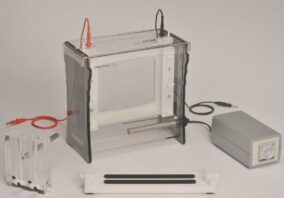DGGE: denaturing gradient gel electrophoresis
Denaturing gradient gel electrophoresis or DGGE is an electrophoresis technique used to separate nucleic acid molecules (DNA or RNA) of the same size. It consists in depositing a nucleic acid sample on an electrophoresis gel containing a denaturing agent (for example urea). In a DGGE gel, the nucleic acid fragments are subjected to different increasing concentrations of denaturant agent. The 2 DNA strands separate more or less quickly depending on their composition in AT and GC bases (2 hydrogen bonds for AT versus 3 for GC). Two different molecules can have strands that will not separate at the same time and will then migrate differently. The more stable molecule will migrate slower than the one that will denature in the gradient. The DGGE system requires slow migration at low voltage in order to better separate DNA fragments. In order to increase the distinction between different fragments of the same size but of slightly different sequence, a GC-clamp sequence (30 to 60 GT bases) is added to one of the PCR amplification primers.
Advantages
- Comparison of microbial communities (various sources: soil, polluted waters...)
- Analysis of ribosomal RNA gene diversity (16S or 18S) of natural microbial populations (soil, aquatic environments). Direct diagnosis of genetic diseases
